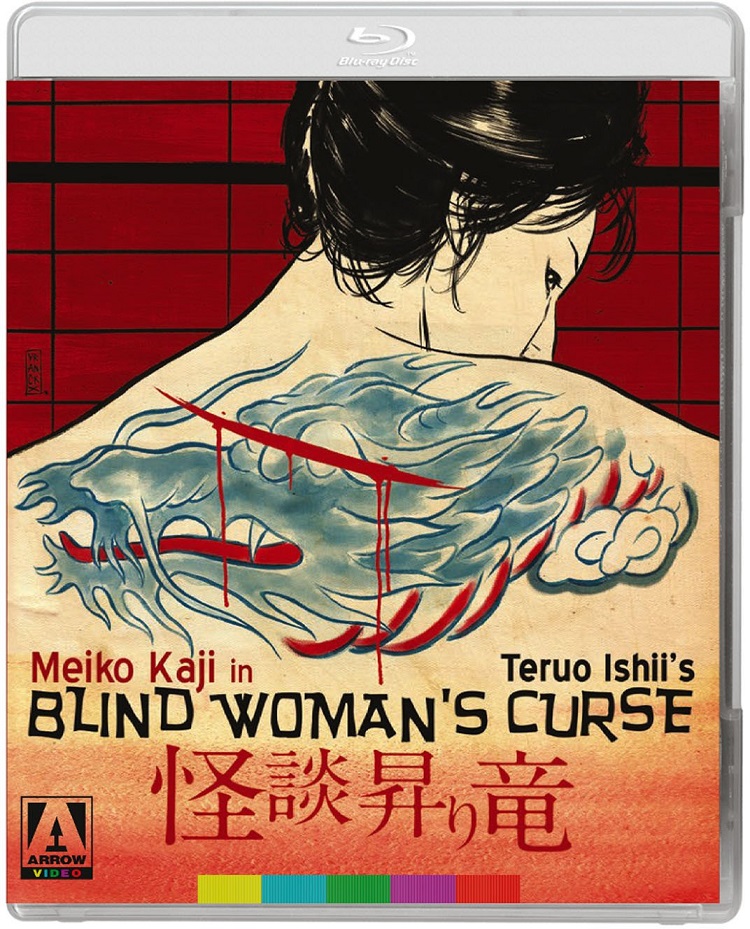
Blind Woman’s Curse, directed by Teruo Ishii and due out on Blu-ray on April 21 from Arrow Video, is a fine example of the kind of leeway that was allowed in Japanese studio films. As long as the movie had enough elements that looked like it belonged to a genre, Japanese exploitation movies of the ’60s and ’70s would go to surprising artistic places, and most often with extremely professional technical results. This movie, on the surface a mix of a Yakuza story about a female boss of an early 20th century Japanese gang and a ghost story with a mysterious black cat, takes any number of weird twists and turns, both visually and in terms of storytelling. Simple story coherency is not job one here, but entertaining oddness is.
Blind Woman’s Curse is largely about Akemi, the female inheritor of the Tachibana gang. The movie opens with a rain-soaked battle where Akemi blinds a woman trying to protect her brother. Then a black cat licks the blinded woman’s wounds, and attacks Akemi. Then Akemi wakes up in jail, because it was a nightmare. Next scene is a couple of years later, with Akemi out and her former jailmates wanting to join up with her gang. It isn’t clear that the dream really happened until eventually a blind woman sword master comes to take vengeance… except most of the vengeance is actually the work of her hunchback would-be boyfriend.
If the above seems like an almost Lynchian jumble of nonsense, that’s because it is. Not to mention the strong man who interrupts a gang war just to get in on the fight, until he decides to become a waiter in a restaurant to, apparently, reform himself. And Akemi kind of loves him. And there’s the flatulent third gang boss who wants to take over Akemi’s territory, until he disappears for about an hour so another gang can rival with Akemi.
Have I already mentioned the hunchback? An actor (and, to some degree, performance) borrowed from Teruo Ishii’s earlier film, Horrors of Malformed Men, he doesn’t fit at all in a Yakuza movie, or really a ghost story, but this isn’t a movie about parts fitting in.
Blind Woman’s Curse has some of the atmosphere of a samurai movie (and all of the significant fights in the movie are katana based) while not having a single samurai in it. Though it’s never explicitly stated the time period seems to be in the 1920s, decades after the samurai had been outlawed. Most of the costumes are traditional Japanese, though one gang wears then-modern Western outfits, with waistcoats and bowler hats. There is gruesomeness (including some gory skinning) and the fights are often extremely bloody in that satisfying, spurting artery way of ’70s cinema.
In this kind of movie, for a casual viewer enjoyment is found in the broad strokes, in the parts, rather than their sum. So the Blind Woman’s plan for vengeance seems to mainly involve her waiting around. So the main character disappears for half an hour. So there’s a gang fight near the beginning with characters who then completely disappear from the movie… until they come back, halfway through the movie, without much context or consequence. It’s all in good fun.
The performances and performers are all up for the challenge of navigating this kaleidoscope of genre elements. Akemi is played by Meiko Keji, best known to Western audiences as the lead in Lady Snowblood. Besides being really astoundingly pretty, she wears the assumed authority of a lady gang leader well. As is fairly typical of a Japanese studio genre film, many of the other performances are broadly comic, (Akemi’s new girl gang members sure do giggle a lot for tough criminals) and numerous – for an 85-minute actioner there’s a lot of different people and motivations to keep track of.
What’s always interesting about these Japanese genre films is that, even for a small movie like this one the production values are so high, which this excellent looking Blu-ray amply shows off. Crowd scenes are always filled out with huge numbers of people in authentic-looking traditional garb. The action sequences often have a dozen people all squaring off (except, of course, for the climactic one on one battle between Akemi and the blind woman who has cursed her). The locations are often standing sets reused for several movies, so they have an solidity and depth to them. Cheap genre movies made in Japan, especially in the ’60s and ’70s, just tend to look great.
And though Blind Woman’s Curse is far from typical, it’s not an exception. I was perfectly happy watching it as a Japanese cinephile, and largely knew what I was getting into (though the hunchback who could leap over buildings and creates tableaus out of body parts was not something I predicted). If you have a taste for the weird, small, and Japanese, it’s a memorable ride.
Included on the Blu-ray is a commentary track by Jasper Sharp, a Japanese cinema expert who places the film into its historical context, and discusses the careers of several people involved, on and off screen. I found it a great, scholarly listen.